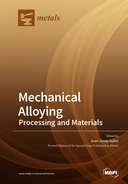Explore

Mechanical Alloying: Processing and Materials
0 Ungluers have
Faved this Work
Login to Fave
Mechanical alloying is a technique of producing alloys and compounds that permits the development of metastable materials (with amorphous or nanocrystalline microstructure) or the fabrication of solid solutions with extended solubility. The elements or compounds to be mixed (usually as powders) are introduced in jars usually under a controlled atmosphere. Regarding the scope of this book, advanced materials have been developed by mechanical alloying: Fe–X–B–Cu (X = Nb, NiZr) nanocrystalline alloys, mixtures of the binary Fe–Mn and Fe–Cr alloys with chromium and manganese nitrides, Mn–Al–Co and Mn–Fe alloys, non-equiatomic refractory high-entropy alloys, nanocrystalline Fe–Cr steels, nanaocrystalline Mn–Co–Fe–Ge–Si alloys, Al–Y2O3 nanocomposite, and hydride-forming alloys. Likewise, production conditions and ulterior treatments can provide readers interesting ideas about the procedure to produce alloys with specific microstructure and functional behavior (mechanical, magnetic, corrosion resistance, hydrogen storage, magnetocaloric effect, wastewater treatment, and so on). As an example, to obtain the improvement in the functional properties of the alloys and compounds, sometimes controlled annealing is needed (annealing provokes the relaxation of the mechanical-induced strain). Furthermore, the powders can be consolidated (press, spark plasma sintering,and microwave sintering) to obtain bulk materials.
This book is included in DOAB.
Why read this book? Have your say.
You must be logged in to comment.
